Information Technology: Analysis of IoT in the Retail Sector
VerifiedAdded on 2020/05/28
|16
|4687
|139
Report
AI Summary
This report provides a comprehensive analysis of the Internet of Things (IoT) in the retail sector. It begins with an executive summary and table of contents, followed by an introduction outlining the growing impact of IoT on retail operations. The report reviews relevant literature and analyzes the current state of the retail sector, highlighting how IoT is used for customer data collection, store layout optimization, and product management. It then delves into the security and privacy challenges associated with IoT, including data breaches and network vulnerabilities, and suggests methods for mitigating these risks. The report evaluates potential solutions, discusses the technologies used in IoT, and explores the future of retail business with IoT, including the impact on various business processes. The report concludes by summarizing the key findings and offering recommendations for businesses looking to implement IoT. It examines real-world examples, such as Hugo Boss and Dohle, to illustrate the practical applications of IoT in the retail environment. The report emphasizes the importance of addressing security and privacy concerns to fully leverage the benefits of IoT in the retail industry.
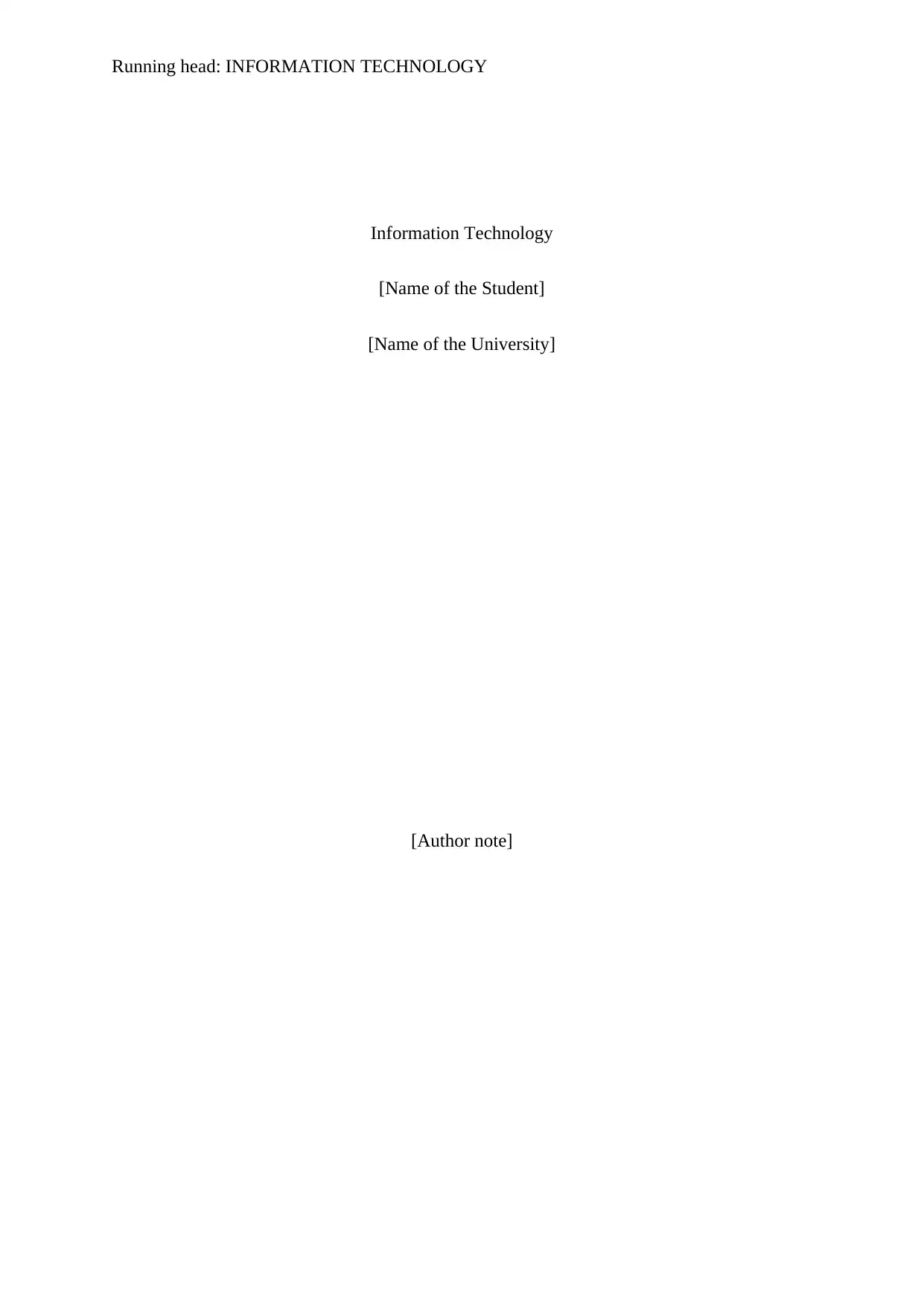
Running head: INFORMATION TECHNOLOGY
Information Technology
[Name of the Student]
[Name of the University]
[Author note]
Information Technology
[Name of the Student]
[Name of the University]
[Author note]
Paraphrase This Document
Need a fresh take? Get an instant paraphrase of this document with our AI Paraphraser
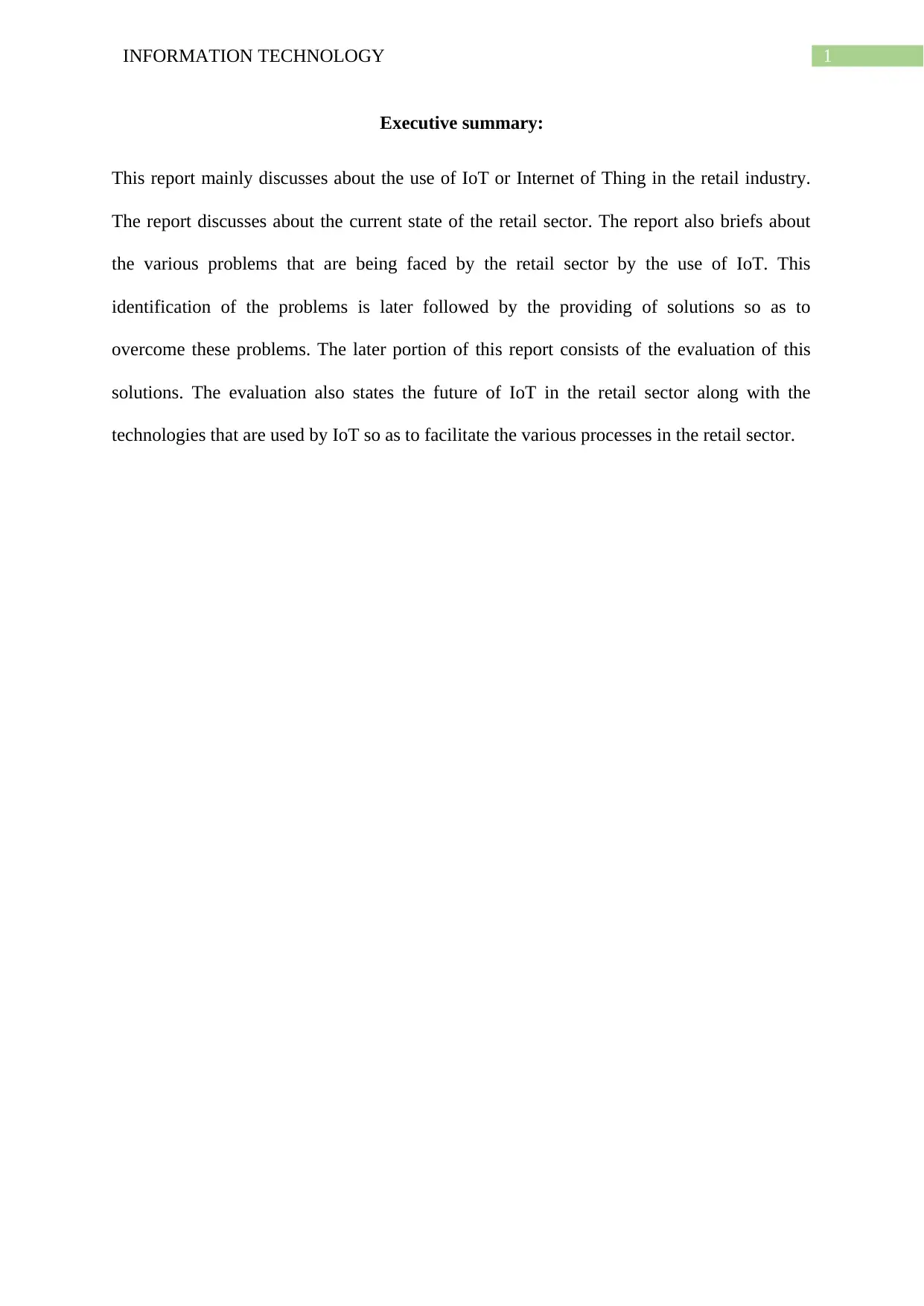
1INFORMATION TECHNOLOGY
Executive summary:
This report mainly discusses about the use of IoT or Internet of Thing in the retail industry.
The report discusses about the current state of the retail sector. The report also briefs about
the various problems that are being faced by the retail sector by the use of IoT. This
identification of the problems is later followed by the providing of solutions so as to
overcome these problems. The later portion of this report consists of the evaluation of this
solutions. The evaluation also states the future of IoT in the retail sector along with the
technologies that are used by IoT so as to facilitate the various processes in the retail sector.
Executive summary:
This report mainly discusses about the use of IoT or Internet of Thing in the retail industry.
The report discusses about the current state of the retail sector. The report also briefs about
the various problems that are being faced by the retail sector by the use of IoT. This
identification of the problems is later followed by the providing of solutions so as to
overcome these problems. The later portion of this report consists of the evaluation of this
solutions. The evaluation also states the future of IoT in the retail sector along with the
technologies that are used by IoT so as to facilitate the various processes in the retail sector.
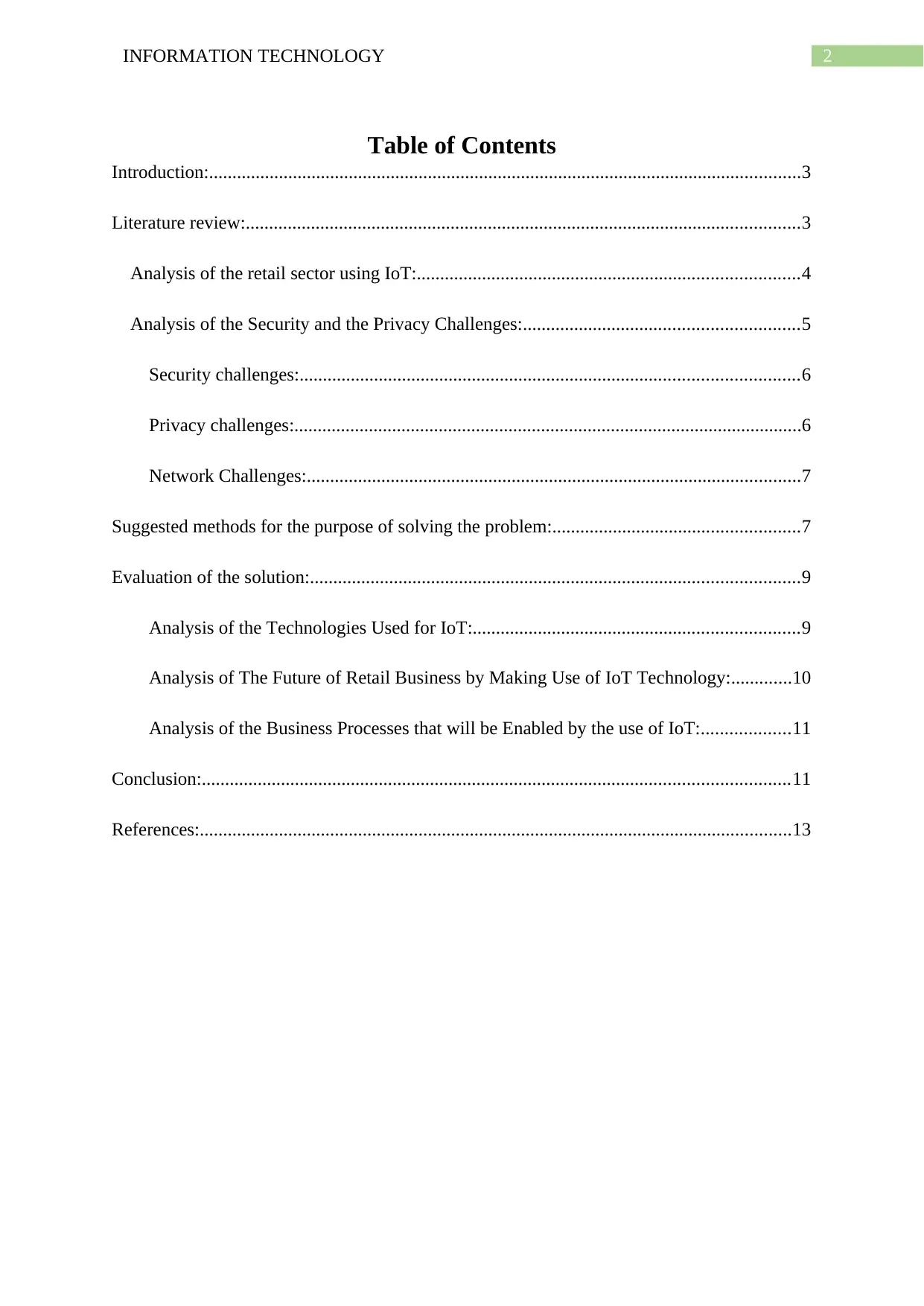
2INFORMATION TECHNOLOGY
Table of Contents
Introduction:...............................................................................................................................3
Literature review:.......................................................................................................................3
Analysis of the retail sector using IoT:..................................................................................4
Analysis of the Security and the Privacy Challenges:...........................................................5
Security challenges:...........................................................................................................6
Privacy challenges:.............................................................................................................6
Network Challenges:..........................................................................................................7
Suggested methods for the purpose of solving the problem:.....................................................7
Evaluation of the solution:.........................................................................................................9
Analysis of the Technologies Used for IoT:......................................................................9
Analysis of The Future of Retail Business by Making Use of IoT Technology:.............10
Analysis of the Business Processes that will be Enabled by the use of IoT:...................11
Conclusion:..............................................................................................................................11
References:...............................................................................................................................13
Table of Contents
Introduction:...............................................................................................................................3
Literature review:.......................................................................................................................3
Analysis of the retail sector using IoT:..................................................................................4
Analysis of the Security and the Privacy Challenges:...........................................................5
Security challenges:...........................................................................................................6
Privacy challenges:.............................................................................................................6
Network Challenges:..........................................................................................................7
Suggested methods for the purpose of solving the problem:.....................................................7
Evaluation of the solution:.........................................................................................................9
Analysis of the Technologies Used for IoT:......................................................................9
Analysis of The Future of Retail Business by Making Use of IoT Technology:.............10
Analysis of the Business Processes that will be Enabled by the use of IoT:...................11
Conclusion:..............................................................................................................................11
References:...............................................................................................................................13
⊘ This is a preview!⊘
Do you want full access?
Subscribe today to unlock all pages.

Trusted by 1+ million students worldwide
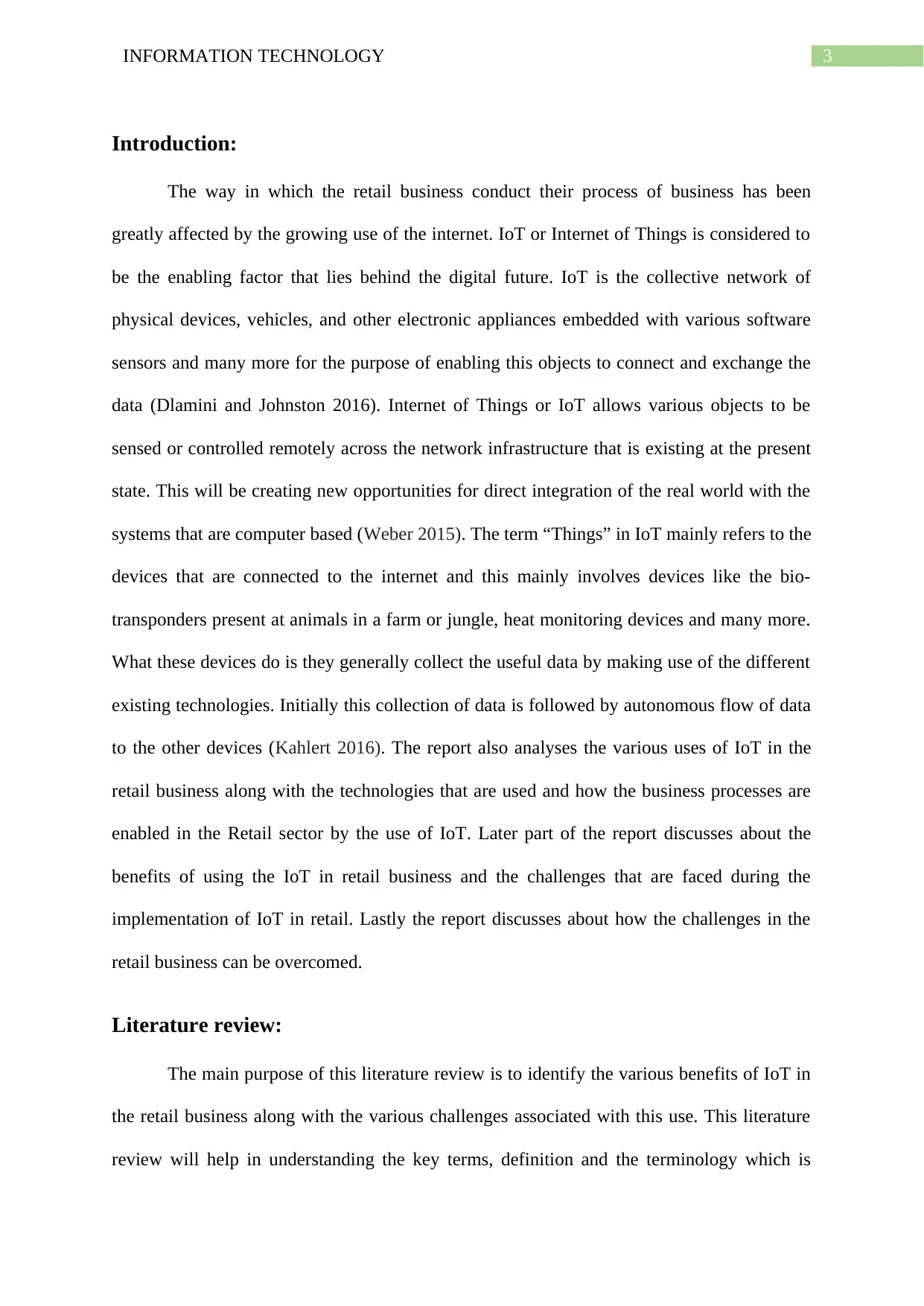
3INFORMATION TECHNOLOGY
Introduction:
The way in which the retail business conduct their process of business has been
greatly affected by the growing use of the internet. IoT or Internet of Things is considered to
be the enabling factor that lies behind the digital future. IoT is the collective network of
physical devices, vehicles, and other electronic appliances embedded with various software
sensors and many more for the purpose of enabling this objects to connect and exchange the
data (Dlamini and Johnston 2016). Internet of Things or IoT allows various objects to be
sensed or controlled remotely across the network infrastructure that is existing at the present
state. This will be creating new opportunities for direct integration of the real world with the
systems that are computer based (Weber 2015). The term “Things” in IoT mainly refers to the
devices that are connected to the internet and this mainly involves devices like the bio-
transponders present at animals in a farm or jungle, heat monitoring devices and many more.
What these devices do is they generally collect the useful data by making use of the different
existing technologies. Initially this collection of data is followed by autonomous flow of data
to the other devices (Kahlert 2016). The report also analyses the various uses of IoT in the
retail business along with the technologies that are used and how the business processes are
enabled in the Retail sector by the use of IoT. Later part of the report discusses about the
benefits of using the IoT in retail business and the challenges that are faced during the
implementation of IoT in retail. Lastly the report discusses about how the challenges in the
retail business can be overcomed.
Literature review:
The main purpose of this literature review is to identify the various benefits of IoT in
the retail business along with the various challenges associated with this use. This literature
review will help in understanding the key terms, definition and the terminology which is
Introduction:
The way in which the retail business conduct their process of business has been
greatly affected by the growing use of the internet. IoT or Internet of Things is considered to
be the enabling factor that lies behind the digital future. IoT is the collective network of
physical devices, vehicles, and other electronic appliances embedded with various software
sensors and many more for the purpose of enabling this objects to connect and exchange the
data (Dlamini and Johnston 2016). Internet of Things or IoT allows various objects to be
sensed or controlled remotely across the network infrastructure that is existing at the present
state. This will be creating new opportunities for direct integration of the real world with the
systems that are computer based (Weber 2015). The term “Things” in IoT mainly refers to the
devices that are connected to the internet and this mainly involves devices like the bio-
transponders present at animals in a farm or jungle, heat monitoring devices and many more.
What these devices do is they generally collect the useful data by making use of the different
existing technologies. Initially this collection of data is followed by autonomous flow of data
to the other devices (Kahlert 2016). The report also analyses the various uses of IoT in the
retail business along with the technologies that are used and how the business processes are
enabled in the Retail sector by the use of IoT. Later part of the report discusses about the
benefits of using the IoT in retail business and the challenges that are faced during the
implementation of IoT in retail. Lastly the report discusses about how the challenges in the
retail business can be overcomed.
Literature review:
The main purpose of this literature review is to identify the various benefits of IoT in
the retail business along with the various challenges associated with this use. This literature
review will help in understanding the key terms, definition and the terminology which is
Paraphrase This Document
Need a fresh take? Get an instant paraphrase of this document with our AI Paraphraser
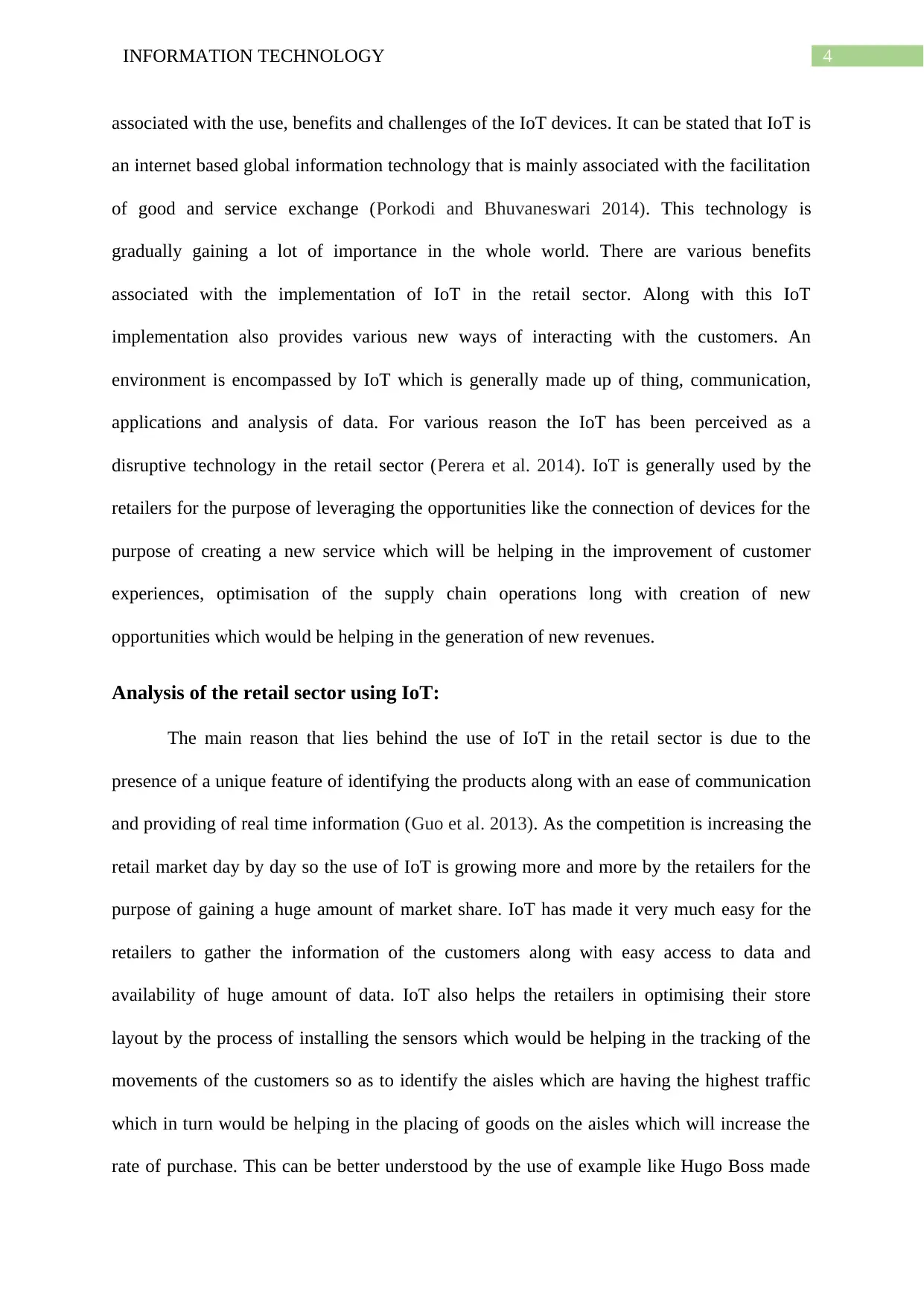
4INFORMATION TECHNOLOGY
associated with the use, benefits and challenges of the IoT devices. It can be stated that IoT is
an internet based global information technology that is mainly associated with the facilitation
of good and service exchange (Porkodi and Bhuvaneswari 2014). This technology is
gradually gaining a lot of importance in the whole world. There are various benefits
associated with the implementation of IoT in the retail sector. Along with this IoT
implementation also provides various new ways of interacting with the customers. An
environment is encompassed by IoT which is generally made up of thing, communication,
applications and analysis of data. For various reason the IoT has been perceived as a
disruptive technology in the retail sector (Perera et al. 2014). IoT is generally used by the
retailers for the purpose of leveraging the opportunities like the connection of devices for the
purpose of creating a new service which will be helping in the improvement of customer
experiences, optimisation of the supply chain operations long with creation of new
opportunities which would be helping in the generation of new revenues.
Analysis of the retail sector using IoT:
The main reason that lies behind the use of IoT in the retail sector is due to the
presence of a unique feature of identifying the products along with an ease of communication
and providing of real time information (Guo et al. 2013). As the competition is increasing the
retail market day by day so the use of IoT is growing more and more by the retailers for the
purpose of gaining a huge amount of market share. IoT has made it very much easy for the
retailers to gather the information of the customers along with easy access to data and
availability of huge amount of data. IoT also helps the retailers in optimising their store
layout by the process of installing the sensors which would be helping in the tracking of the
movements of the customers so as to identify the aisles which are having the highest traffic
which in turn would be helping in the placing of goods on the aisles which will increase the
rate of purchase. This can be better understood by the use of example like Hugo Boss made
associated with the use, benefits and challenges of the IoT devices. It can be stated that IoT is
an internet based global information technology that is mainly associated with the facilitation
of good and service exchange (Porkodi and Bhuvaneswari 2014). This technology is
gradually gaining a lot of importance in the whole world. There are various benefits
associated with the implementation of IoT in the retail sector. Along with this IoT
implementation also provides various new ways of interacting with the customers. An
environment is encompassed by IoT which is generally made up of thing, communication,
applications and analysis of data. For various reason the IoT has been perceived as a
disruptive technology in the retail sector (Perera et al. 2014). IoT is generally used by the
retailers for the purpose of leveraging the opportunities like the connection of devices for the
purpose of creating a new service which will be helping in the improvement of customer
experiences, optimisation of the supply chain operations long with creation of new
opportunities which would be helping in the generation of new revenues.
Analysis of the retail sector using IoT:
The main reason that lies behind the use of IoT in the retail sector is due to the
presence of a unique feature of identifying the products along with an ease of communication
and providing of real time information (Guo et al. 2013). As the competition is increasing the
retail market day by day so the use of IoT is growing more and more by the retailers for the
purpose of gaining a huge amount of market share. IoT has made it very much easy for the
retailers to gather the information of the customers along with easy access to data and
availability of huge amount of data. IoT also helps the retailers in optimising their store
layout by the process of installing the sensors which would be helping in the tracking of the
movements of the customers so as to identify the aisles which are having the highest traffic
which in turn would be helping in the placing of goods on the aisles which will increase the
rate of purchase. This can be better understood by the use of example like Hugo Boss made
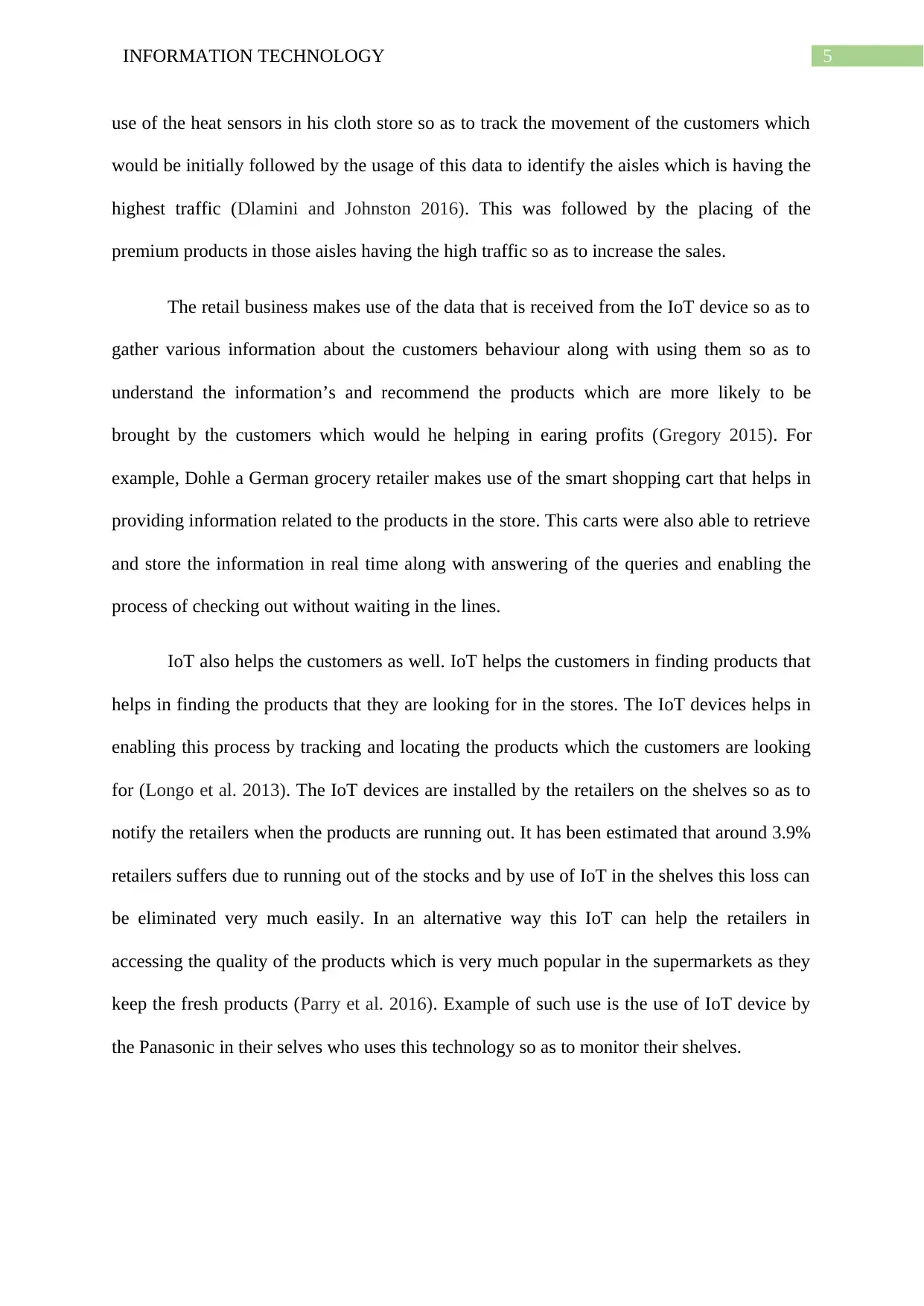
5INFORMATION TECHNOLOGY
use of the heat sensors in his cloth store so as to track the movement of the customers which
would be initially followed by the usage of this data to identify the aisles which is having the
highest traffic (Dlamini and Johnston 2016). This was followed by the placing of the
premium products in those aisles having the high traffic so as to increase the sales.
The retail business makes use of the data that is received from the IoT device so as to
gather various information about the customers behaviour along with using them so as to
understand the information’s and recommend the products which are more likely to be
brought by the customers which would he helping in earing profits (Gregory 2015). For
example, Dohle a German grocery retailer makes use of the smart shopping cart that helps in
providing information related to the products in the store. This carts were also able to retrieve
and store the information in real time along with answering of the queries and enabling the
process of checking out without waiting in the lines.
IoT also helps the customers as well. IoT helps the customers in finding products that
helps in finding the products that they are looking for in the stores. The IoT devices helps in
enabling this process by tracking and locating the products which the customers are looking
for (Longo et al. 2013). The IoT devices are installed by the retailers on the shelves so as to
notify the retailers when the products are running out. It has been estimated that around 3.9%
retailers suffers due to running out of the stocks and by use of IoT in the shelves this loss can
be eliminated very much easily. In an alternative way this IoT can help the retailers in
accessing the quality of the products which is very much popular in the supermarkets as they
keep the fresh products (Parry et al. 2016). Example of such use is the use of IoT device by
the Panasonic in their selves who uses this technology so as to monitor their shelves.
use of the heat sensors in his cloth store so as to track the movement of the customers which
would be initially followed by the usage of this data to identify the aisles which is having the
highest traffic (Dlamini and Johnston 2016). This was followed by the placing of the
premium products in those aisles having the high traffic so as to increase the sales.
The retail business makes use of the data that is received from the IoT device so as to
gather various information about the customers behaviour along with using them so as to
understand the information’s and recommend the products which are more likely to be
brought by the customers which would he helping in earing profits (Gregory 2015). For
example, Dohle a German grocery retailer makes use of the smart shopping cart that helps in
providing information related to the products in the store. This carts were also able to retrieve
and store the information in real time along with answering of the queries and enabling the
process of checking out without waiting in the lines.
IoT also helps the customers as well. IoT helps the customers in finding products that
helps in finding the products that they are looking for in the stores. The IoT devices helps in
enabling this process by tracking and locating the products which the customers are looking
for (Longo et al. 2013). The IoT devices are installed by the retailers on the shelves so as to
notify the retailers when the products are running out. It has been estimated that around 3.9%
retailers suffers due to running out of the stocks and by use of IoT in the shelves this loss can
be eliminated very much easily. In an alternative way this IoT can help the retailers in
accessing the quality of the products which is very much popular in the supermarkets as they
keep the fresh products (Parry et al. 2016). Example of such use is the use of IoT device by
the Panasonic in their selves who uses this technology so as to monitor their shelves.
⊘ This is a preview!⊘
Do you want full access?
Subscribe today to unlock all pages.

Trusted by 1+ million students worldwide
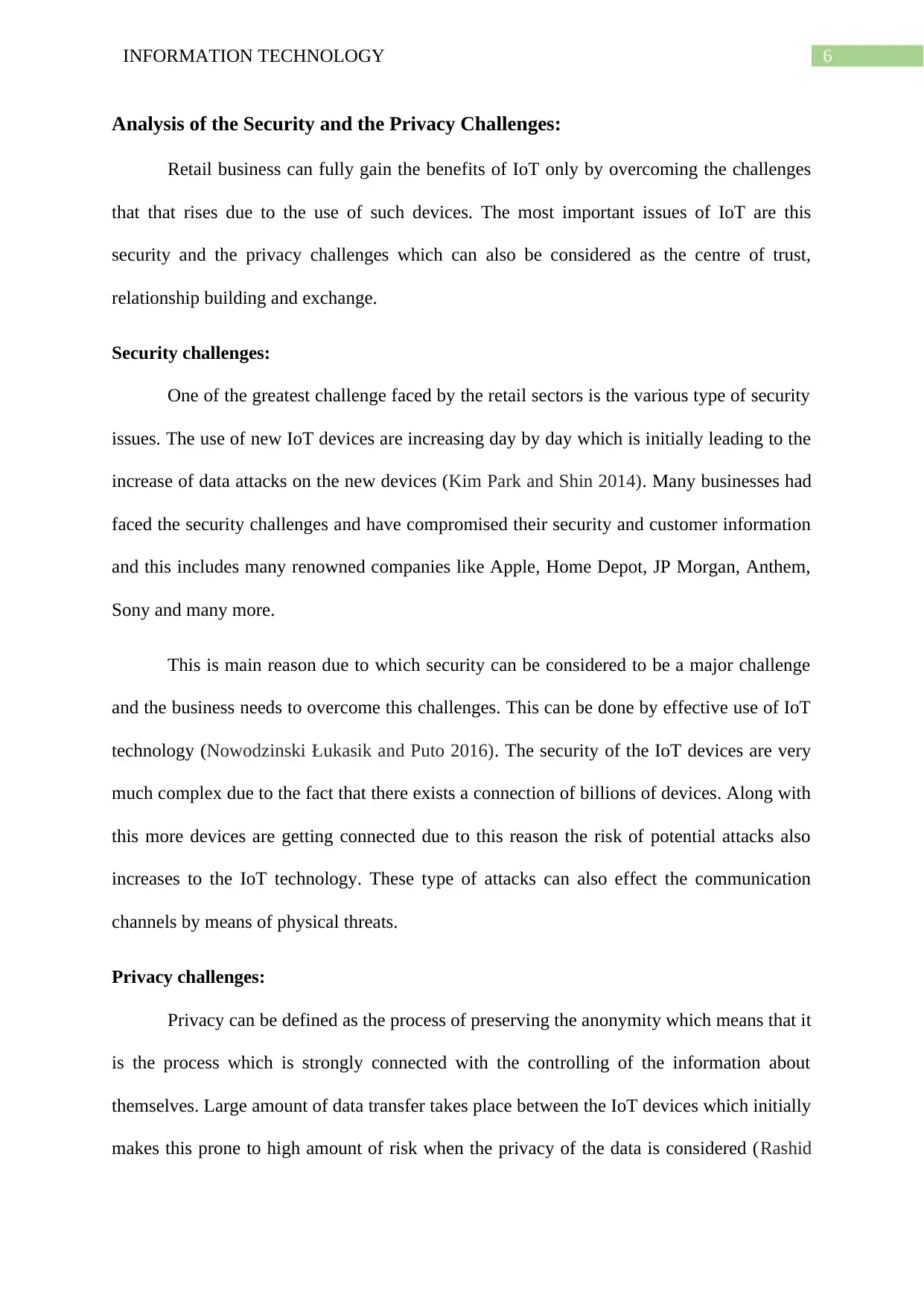
6INFORMATION TECHNOLOGY
Analysis of the Security and the Privacy Challenges:
Retail business can fully gain the benefits of IoT only by overcoming the challenges
that that rises due to the use of such devices. The most important issues of IoT are this
security and the privacy challenges which can also be considered as the centre of trust,
relationship building and exchange.
Security challenges:
One of the greatest challenge faced by the retail sectors is the various type of security
issues. The use of new IoT devices are increasing day by day which is initially leading to the
increase of data attacks on the new devices (Kim Park and Shin 2014). Many businesses had
faced the security challenges and have compromised their security and customer information
and this includes many renowned companies like Apple, Home Depot, JP Morgan, Anthem,
Sony and many more.
This is main reason due to which security can be considered to be a major challenge
and the business needs to overcome this challenges. This can be done by effective use of IoT
technology (Nowodzinski Łukasik and Puto 2016). The security of the IoT devices are very
much complex due to the fact that there exists a connection of billions of devices. Along with
this more devices are getting connected due to this reason the risk of potential attacks also
increases to the IoT technology. These type of attacks can also effect the communication
channels by means of physical threats.
Privacy challenges:
Privacy can be defined as the process of preserving the anonymity which means that it
is the process which is strongly connected with the controlling of the information about
themselves. Large amount of data transfer takes place between the IoT devices which initially
makes this prone to high amount of risk when the privacy of the data is considered (Rashid
Analysis of the Security and the Privacy Challenges:
Retail business can fully gain the benefits of IoT only by overcoming the challenges
that that rises due to the use of such devices. The most important issues of IoT are this
security and the privacy challenges which can also be considered as the centre of trust,
relationship building and exchange.
Security challenges:
One of the greatest challenge faced by the retail sectors is the various type of security
issues. The use of new IoT devices are increasing day by day which is initially leading to the
increase of data attacks on the new devices (Kim Park and Shin 2014). Many businesses had
faced the security challenges and have compromised their security and customer information
and this includes many renowned companies like Apple, Home Depot, JP Morgan, Anthem,
Sony and many more.
This is main reason due to which security can be considered to be a major challenge
and the business needs to overcome this challenges. This can be done by effective use of IoT
technology (Nowodzinski Łukasik and Puto 2016). The security of the IoT devices are very
much complex due to the fact that there exists a connection of billions of devices. Along with
this more devices are getting connected due to this reason the risk of potential attacks also
increases to the IoT technology. These type of attacks can also effect the communication
channels by means of physical threats.
Privacy challenges:
Privacy can be defined as the process of preserving the anonymity which means that it
is the process which is strongly connected with the controlling of the information about
themselves. Large amount of data transfer takes place between the IoT devices which initially
makes this prone to high amount of risk when the privacy of the data is considered (Rashid
Paraphrase This Document
Need a fresh take? Get an instant paraphrase of this document with our AI Paraphraser
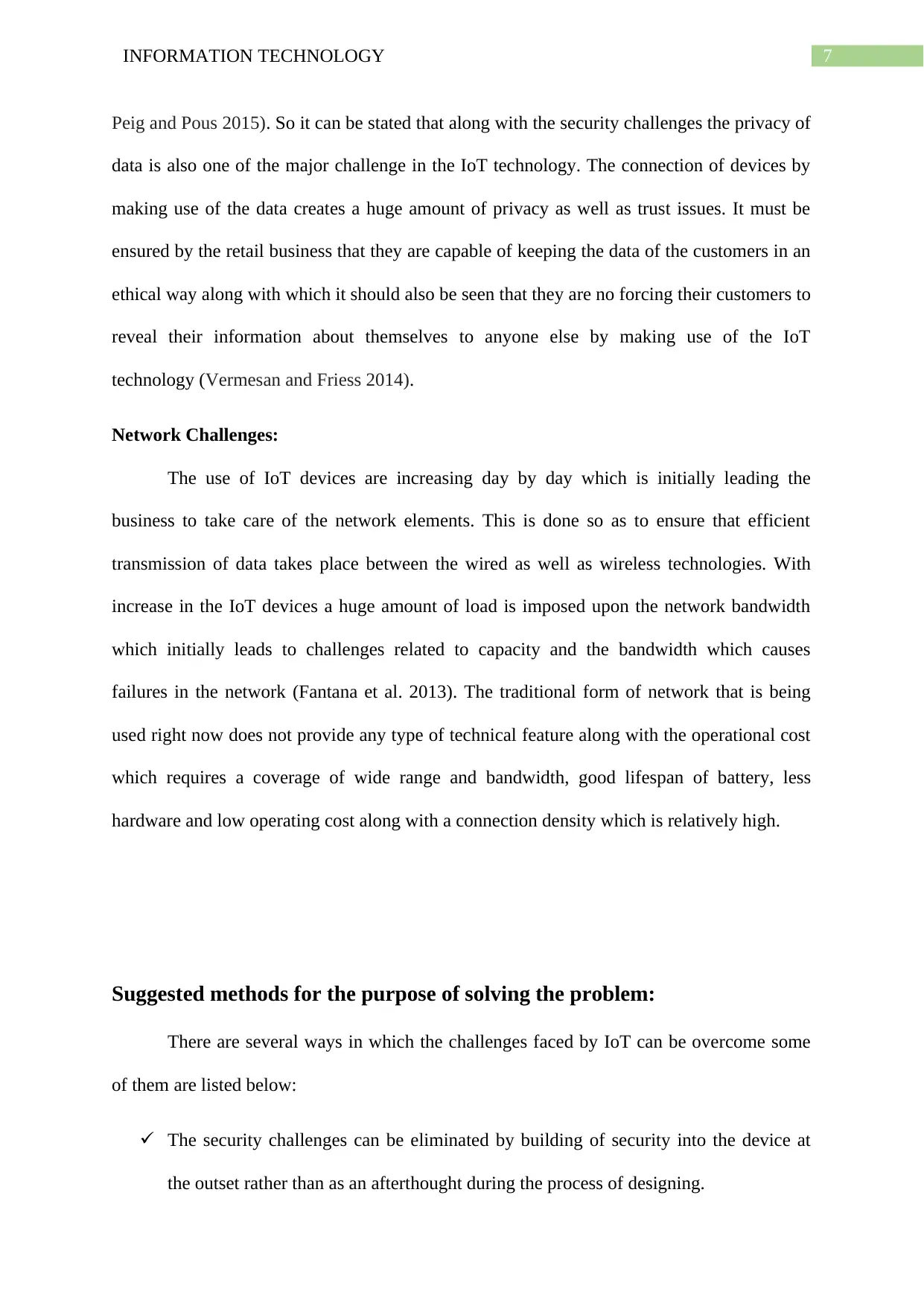
7INFORMATION TECHNOLOGY
Peig and Pous 2015). So it can be stated that along with the security challenges the privacy of
data is also one of the major challenge in the IoT technology. The connection of devices by
making use of the data creates a huge amount of privacy as well as trust issues. It must be
ensured by the retail business that they are capable of keeping the data of the customers in an
ethical way along with which it should also be seen that they are no forcing their customers to
reveal their information about themselves to anyone else by making use of the IoT
technology (Vermesan and Friess 2014).
Network Challenges:
The use of IoT devices are increasing day by day which is initially leading the
business to take care of the network elements. This is done so as to ensure that efficient
transmission of data takes place between the wired as well as wireless technologies. With
increase in the IoT devices a huge amount of load is imposed upon the network bandwidth
which initially leads to challenges related to capacity and the bandwidth which causes
failures in the network (Fantana et al. 2013). The traditional form of network that is being
used right now does not provide any type of technical feature along with the operational cost
which requires a coverage of wide range and bandwidth, good lifespan of battery, less
hardware and low operating cost along with a connection density which is relatively high.
Suggested methods for the purpose of solving the problem:
There are several ways in which the challenges faced by IoT can be overcome some
of them are listed below:
The security challenges can be eliminated by building of security into the device at
the outset rather than as an afterthought during the process of designing.
Peig and Pous 2015). So it can be stated that along with the security challenges the privacy of
data is also one of the major challenge in the IoT technology. The connection of devices by
making use of the data creates a huge amount of privacy as well as trust issues. It must be
ensured by the retail business that they are capable of keeping the data of the customers in an
ethical way along with which it should also be seen that they are no forcing their customers to
reveal their information about themselves to anyone else by making use of the IoT
technology (Vermesan and Friess 2014).
Network Challenges:
The use of IoT devices are increasing day by day which is initially leading the
business to take care of the network elements. This is done so as to ensure that efficient
transmission of data takes place between the wired as well as wireless technologies. With
increase in the IoT devices a huge amount of load is imposed upon the network bandwidth
which initially leads to challenges related to capacity and the bandwidth which causes
failures in the network (Fantana et al. 2013). The traditional form of network that is being
used right now does not provide any type of technical feature along with the operational cost
which requires a coverage of wide range and bandwidth, good lifespan of battery, less
hardware and low operating cost along with a connection density which is relatively high.
Suggested methods for the purpose of solving the problem:
There are several ways in which the challenges faced by IoT can be overcome some
of them are listed below:
The security challenges can be eliminated by building of security into the device at
the outset rather than as an afterthought during the process of designing.
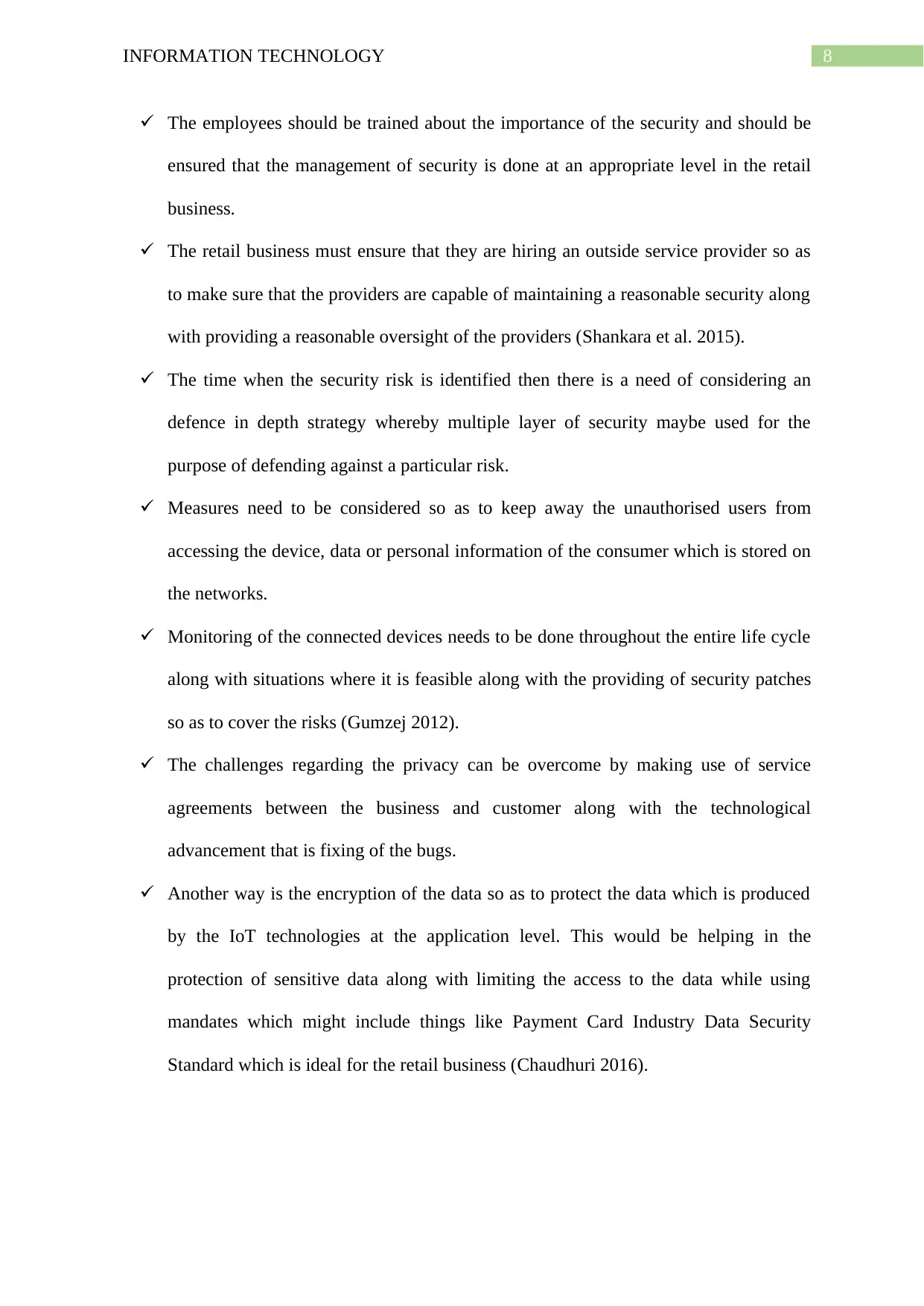
8INFORMATION TECHNOLOGY
The employees should be trained about the importance of the security and should be
ensured that the management of security is done at an appropriate level in the retail
business.
The retail business must ensure that they are hiring an outside service provider so as
to make sure that the providers are capable of maintaining a reasonable security along
with providing a reasonable oversight of the providers (Shankara et al. 2015).
The time when the security risk is identified then there is a need of considering an
defence in depth strategy whereby multiple layer of security maybe used for the
purpose of defending against a particular risk.
Measures need to be considered so as to keep away the unauthorised users from
accessing the device, data or personal information of the consumer which is stored on
the networks.
Monitoring of the connected devices needs to be done throughout the entire life cycle
along with situations where it is feasible along with the providing of security patches
so as to cover the risks (Gumzej 2012).
The challenges regarding the privacy can be overcome by making use of service
agreements between the business and customer along with the technological
advancement that is fixing of the bugs.
Another way is the encryption of the data so as to protect the data which is produced
by the IoT technologies at the application level. This would be helping in the
protection of sensitive data along with limiting the access to the data while using
mandates which might include things like Payment Card Industry Data Security
Standard which is ideal for the retail business (Chaudhuri 2016).
The employees should be trained about the importance of the security and should be
ensured that the management of security is done at an appropriate level in the retail
business.
The retail business must ensure that they are hiring an outside service provider so as
to make sure that the providers are capable of maintaining a reasonable security along
with providing a reasonable oversight of the providers (Shankara et al. 2015).
The time when the security risk is identified then there is a need of considering an
defence in depth strategy whereby multiple layer of security maybe used for the
purpose of defending against a particular risk.
Measures need to be considered so as to keep away the unauthorised users from
accessing the device, data or personal information of the consumer which is stored on
the networks.
Monitoring of the connected devices needs to be done throughout the entire life cycle
along with situations where it is feasible along with the providing of security patches
so as to cover the risks (Gumzej 2012).
The challenges regarding the privacy can be overcome by making use of service
agreements between the business and customer along with the technological
advancement that is fixing of the bugs.
Another way is the encryption of the data so as to protect the data which is produced
by the IoT technologies at the application level. This would be helping in the
protection of sensitive data along with limiting the access to the data while using
mandates which might include things like Payment Card Industry Data Security
Standard which is ideal for the retail business (Chaudhuri 2016).
⊘ This is a preview!⊘
Do you want full access?
Subscribe today to unlock all pages.

Trusted by 1+ million students worldwide
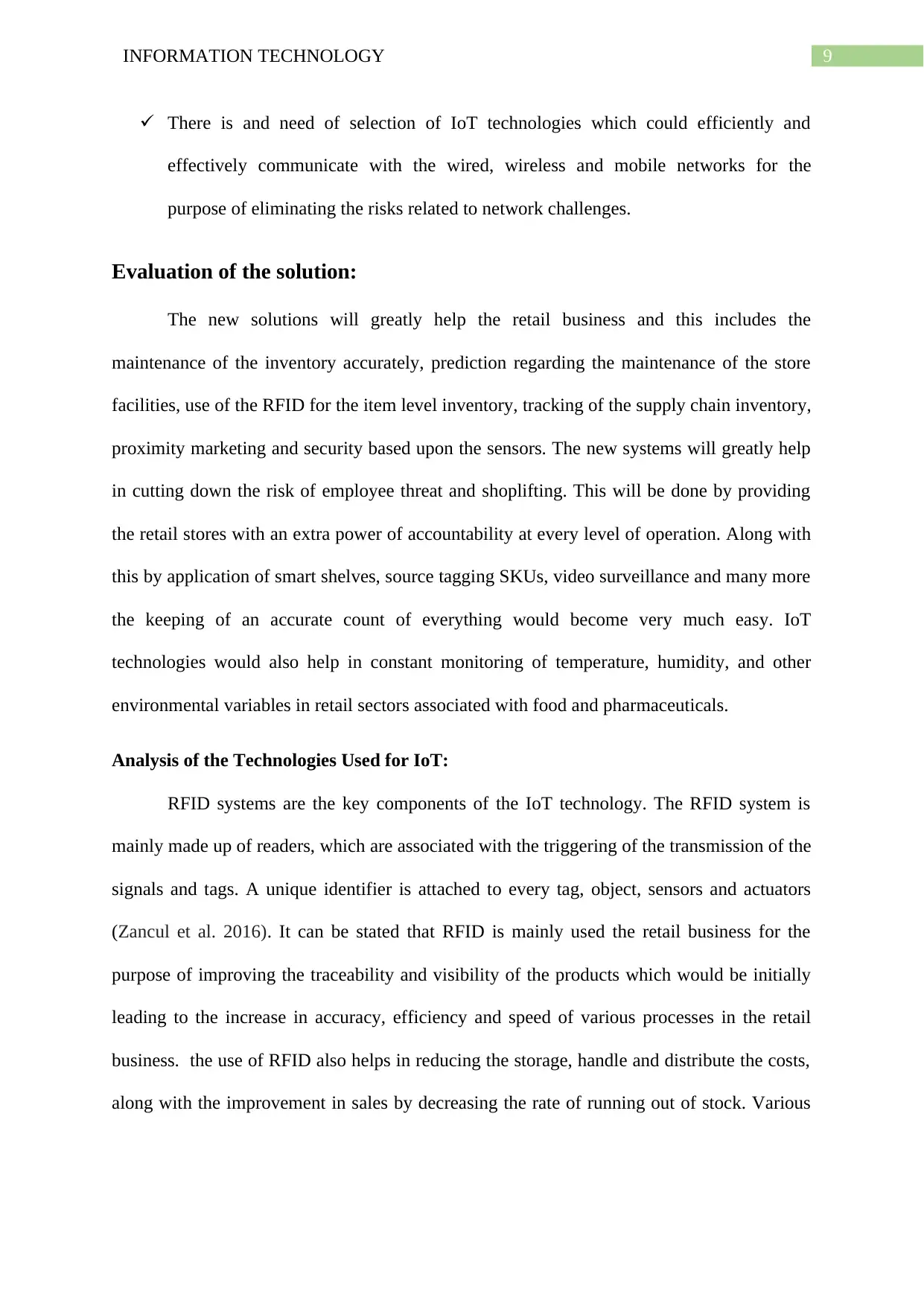
9INFORMATION TECHNOLOGY
There is and need of selection of IoT technologies which could efficiently and
effectively communicate with the wired, wireless and mobile networks for the
purpose of eliminating the risks related to network challenges.
Evaluation of the solution:
The new solutions will greatly help the retail business and this includes the
maintenance of the inventory accurately, prediction regarding the maintenance of the store
facilities, use of the RFID for the item level inventory, tracking of the supply chain inventory,
proximity marketing and security based upon the sensors. The new systems will greatly help
in cutting down the risk of employee threat and shoplifting. This will be done by providing
the retail stores with an extra power of accountability at every level of operation. Along with
this by application of smart shelves, source tagging SKUs, video surveillance and many more
the keeping of an accurate count of everything would become very much easy. IoT
technologies would also help in constant monitoring of temperature, humidity, and other
environmental variables in retail sectors associated with food and pharmaceuticals.
Analysis of the Technologies Used for IoT:
RFID systems are the key components of the IoT technology. The RFID system is
mainly made up of readers, which are associated with the triggering of the transmission of the
signals and tags. A unique identifier is attached to every tag, object, sensors and actuators
(Zancul et al. 2016). It can be stated that RFID is mainly used the retail business for the
purpose of improving the traceability and visibility of the products which would be initially
leading to the increase in accuracy, efficiency and speed of various processes in the retail
business. the use of RFID also helps in reducing the storage, handle and distribute the costs,
along with the improvement in sales by decreasing the rate of running out of stock. Various
There is and need of selection of IoT technologies which could efficiently and
effectively communicate with the wired, wireless and mobile networks for the
purpose of eliminating the risks related to network challenges.
Evaluation of the solution:
The new solutions will greatly help the retail business and this includes the
maintenance of the inventory accurately, prediction regarding the maintenance of the store
facilities, use of the RFID for the item level inventory, tracking of the supply chain inventory,
proximity marketing and security based upon the sensors. The new systems will greatly help
in cutting down the risk of employee threat and shoplifting. This will be done by providing
the retail stores with an extra power of accountability at every level of operation. Along with
this by application of smart shelves, source tagging SKUs, video surveillance and many more
the keeping of an accurate count of everything would become very much easy. IoT
technologies would also help in constant monitoring of temperature, humidity, and other
environmental variables in retail sectors associated with food and pharmaceuticals.
Analysis of the Technologies Used for IoT:
RFID systems are the key components of the IoT technology. The RFID system is
mainly made up of readers, which are associated with the triggering of the transmission of the
signals and tags. A unique identifier is attached to every tag, object, sensors and actuators
(Zancul et al. 2016). It can be stated that RFID is mainly used the retail business for the
purpose of improving the traceability and visibility of the products which would be initially
leading to the increase in accuracy, efficiency and speed of various processes in the retail
business. the use of RFID also helps in reducing the storage, handle and distribute the costs,
along with the improvement in sales by decreasing the rate of running out of stock. Various
Paraphrase This Document
Need a fresh take? Get an instant paraphrase of this document with our AI Paraphraser
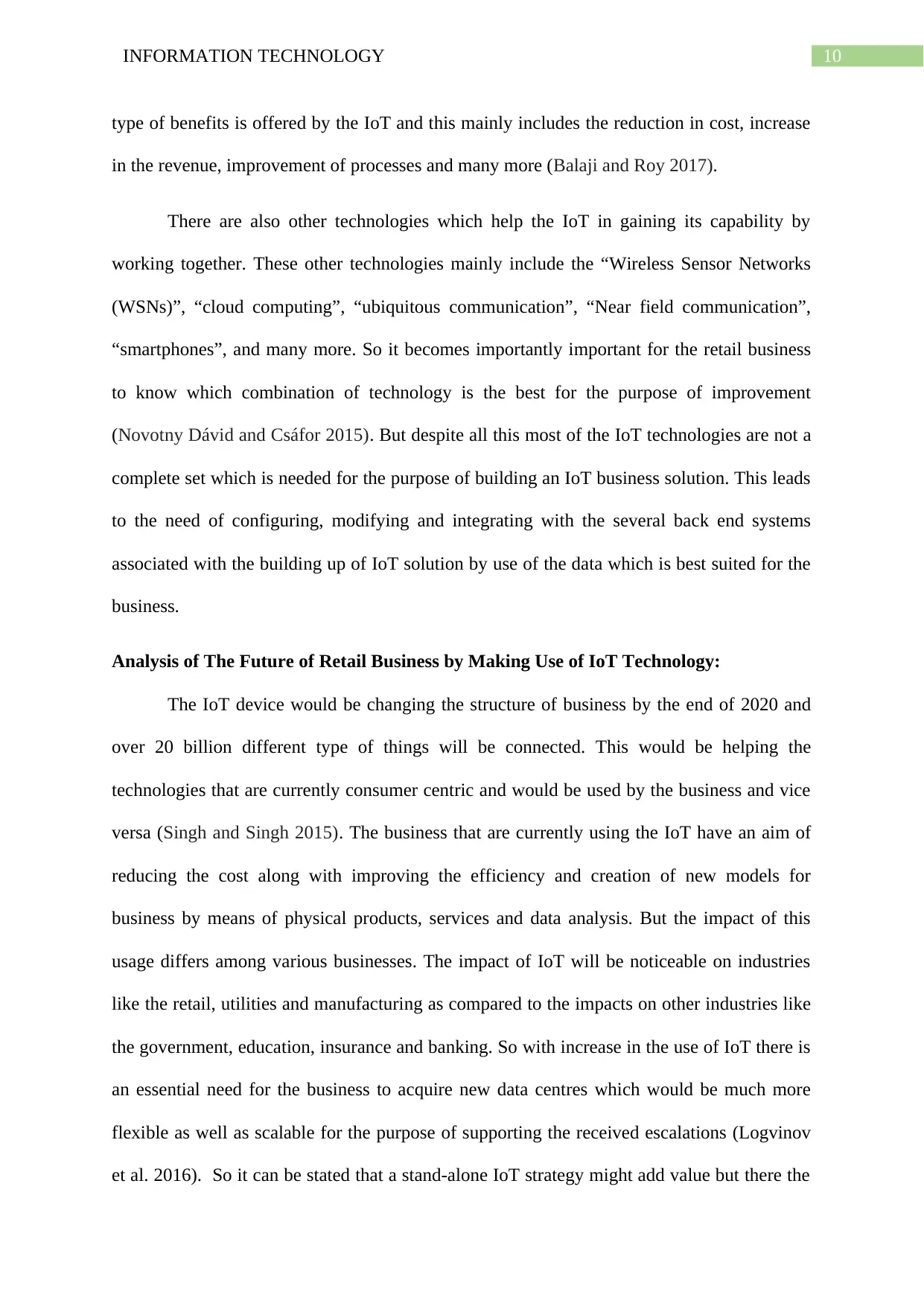
10INFORMATION TECHNOLOGY
type of benefits is offered by the IoT and this mainly includes the reduction in cost, increase
in the revenue, improvement of processes and many more (Balaji and Roy 2017).
There are also other technologies which help the IoT in gaining its capability by
working together. These other technologies mainly include the “Wireless Sensor Networks
(WSNs)”, “cloud computing”, “ubiquitous communication”, “Near field communication”,
“smartphones”, and many more. So it becomes importantly important for the retail business
to know which combination of technology is the best for the purpose of improvement
(Novotny Dávid and Csáfor 2015). But despite all this most of the IoT technologies are not a
complete set which is needed for the purpose of building an IoT business solution. This leads
to the need of configuring, modifying and integrating with the several back end systems
associated with the building up of IoT solution by use of the data which is best suited for the
business.
Analysis of The Future of Retail Business by Making Use of IoT Technology:
The IoT device would be changing the structure of business by the end of 2020 and
over 20 billion different type of things will be connected. This would be helping the
technologies that are currently consumer centric and would be used by the business and vice
versa (Singh and Singh 2015). The business that are currently using the IoT have an aim of
reducing the cost along with improving the efficiency and creation of new models for
business by means of physical products, services and data analysis. But the impact of this
usage differs among various businesses. The impact of IoT will be noticeable on industries
like the retail, utilities and manufacturing as compared to the impacts on other industries like
the government, education, insurance and banking. So with increase in the use of IoT there is
an essential need for the business to acquire new data centres which would be much more
flexible as well as scalable for the purpose of supporting the received escalations (Logvinov
et al. 2016). So it can be stated that a stand-alone IoT strategy might add value but there the
type of benefits is offered by the IoT and this mainly includes the reduction in cost, increase
in the revenue, improvement of processes and many more (Balaji and Roy 2017).
There are also other technologies which help the IoT in gaining its capability by
working together. These other technologies mainly include the “Wireless Sensor Networks
(WSNs)”, “cloud computing”, “ubiquitous communication”, “Near field communication”,
“smartphones”, and many more. So it becomes importantly important for the retail business
to know which combination of technology is the best for the purpose of improvement
(Novotny Dávid and Csáfor 2015). But despite all this most of the IoT technologies are not a
complete set which is needed for the purpose of building an IoT business solution. This leads
to the need of configuring, modifying and integrating with the several back end systems
associated with the building up of IoT solution by use of the data which is best suited for the
business.
Analysis of The Future of Retail Business by Making Use of IoT Technology:
The IoT device would be changing the structure of business by the end of 2020 and
over 20 billion different type of things will be connected. This would be helping the
technologies that are currently consumer centric and would be used by the business and vice
versa (Singh and Singh 2015). The business that are currently using the IoT have an aim of
reducing the cost along with improving the efficiency and creation of new models for
business by means of physical products, services and data analysis. But the impact of this
usage differs among various businesses. The impact of IoT will be noticeable on industries
like the retail, utilities and manufacturing as compared to the impacts on other industries like
the government, education, insurance and banking. So with increase in the use of IoT there is
an essential need for the business to acquire new data centres which would be much more
flexible as well as scalable for the purpose of supporting the received escalations (Logvinov
et al. 2016). So it can be stated that a stand-alone IoT strategy might add value but there the
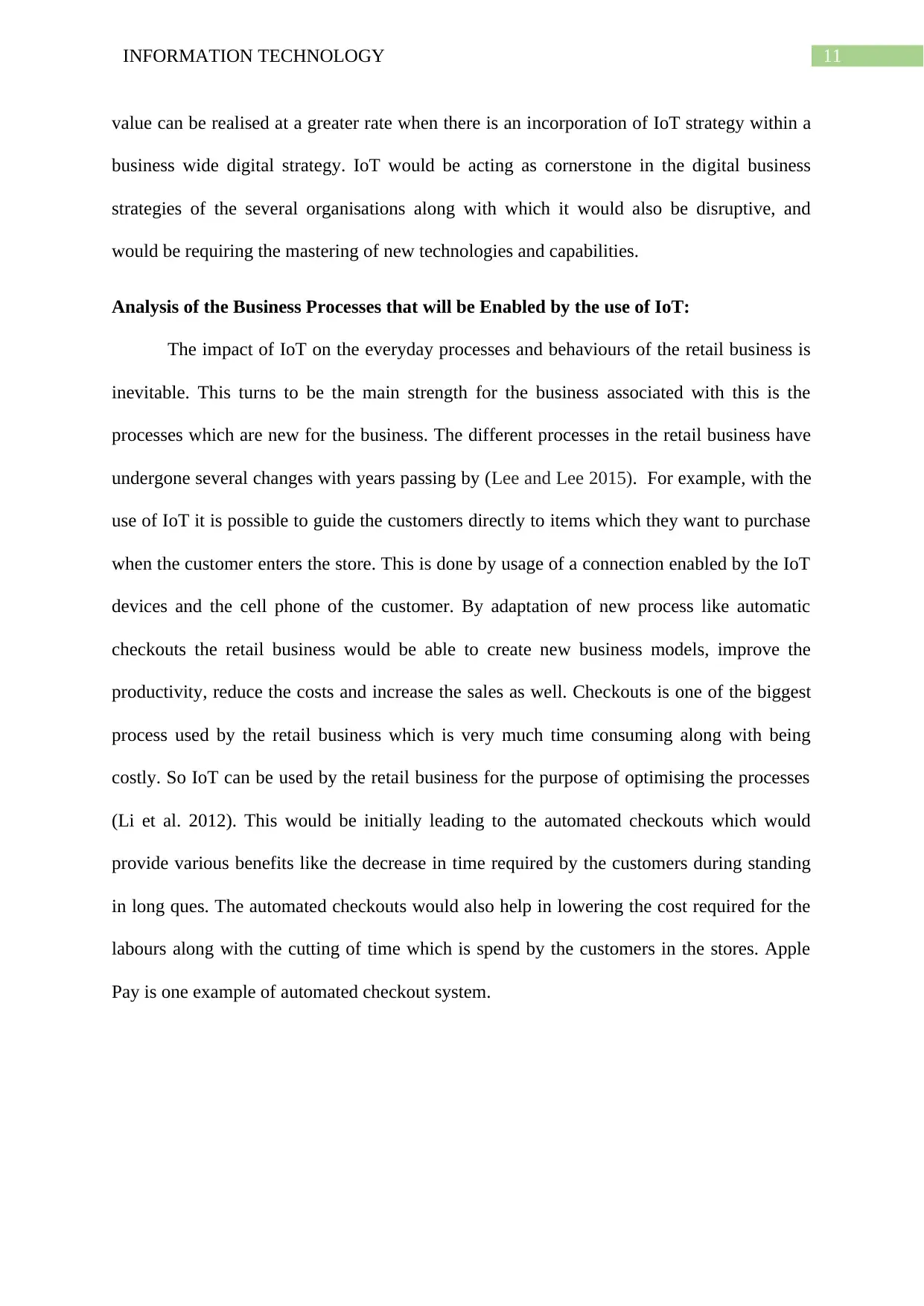
11INFORMATION TECHNOLOGY
value can be realised at a greater rate when there is an incorporation of IoT strategy within a
business wide digital strategy. IoT would be acting as cornerstone in the digital business
strategies of the several organisations along with which it would also be disruptive, and
would be requiring the mastering of new technologies and capabilities.
Analysis of the Business Processes that will be Enabled by the use of IoT:
The impact of IoT on the everyday processes and behaviours of the retail business is
inevitable. This turns to be the main strength for the business associated with this is the
processes which are new for the business. The different processes in the retail business have
undergone several changes with years passing by (Lee and Lee 2015). For example, with the
use of IoT it is possible to guide the customers directly to items which they want to purchase
when the customer enters the store. This is done by usage of a connection enabled by the IoT
devices and the cell phone of the customer. By adaptation of new process like automatic
checkouts the retail business would be able to create new business models, improve the
productivity, reduce the costs and increase the sales as well. Checkouts is one of the biggest
process used by the retail business which is very much time consuming along with being
costly. So IoT can be used by the retail business for the purpose of optimising the processes
(Li et al. 2012). This would be initially leading to the automated checkouts which would
provide various benefits like the decrease in time required by the customers during standing
in long ques. The automated checkouts would also help in lowering the cost required for the
labours along with the cutting of time which is spend by the customers in the stores. Apple
Pay is one example of automated checkout system.
value can be realised at a greater rate when there is an incorporation of IoT strategy within a
business wide digital strategy. IoT would be acting as cornerstone in the digital business
strategies of the several organisations along with which it would also be disruptive, and
would be requiring the mastering of new technologies and capabilities.
Analysis of the Business Processes that will be Enabled by the use of IoT:
The impact of IoT on the everyday processes and behaviours of the retail business is
inevitable. This turns to be the main strength for the business associated with this is the
processes which are new for the business. The different processes in the retail business have
undergone several changes with years passing by (Lee and Lee 2015). For example, with the
use of IoT it is possible to guide the customers directly to items which they want to purchase
when the customer enters the store. This is done by usage of a connection enabled by the IoT
devices and the cell phone of the customer. By adaptation of new process like automatic
checkouts the retail business would be able to create new business models, improve the
productivity, reduce the costs and increase the sales as well. Checkouts is one of the biggest
process used by the retail business which is very much time consuming along with being
costly. So IoT can be used by the retail business for the purpose of optimising the processes
(Li et al. 2012). This would be initially leading to the automated checkouts which would
provide various benefits like the decrease in time required by the customers during standing
in long ques. The automated checkouts would also help in lowering the cost required for the
labours along with the cutting of time which is spend by the customers in the stores. Apple
Pay is one example of automated checkout system.
⊘ This is a preview!⊘
Do you want full access?
Subscribe today to unlock all pages.

Trusted by 1+ million students worldwide
1 out of 16
Related Documents
Your All-in-One AI-Powered Toolkit for Academic Success.
+13062052269
info@desklib.com
Available 24*7 on WhatsApp / Email
![[object Object]](/_next/static/media/star-bottom.7253800d.svg)
Unlock your academic potential
Copyright © 2020–2025 A2Z Services. All Rights Reserved. Developed and managed by ZUCOL.



